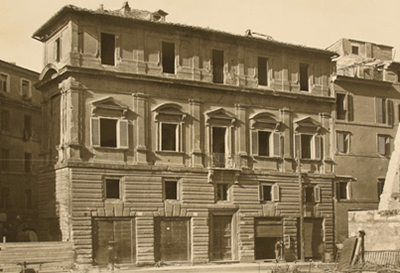Palazzo Jacopo da Brescia is a well known Renaissance royal residence in Rome, which was situated in the Borgo rione region. It was propelled by the neighbouring and now destroyed Palazzo Caprini by the famous Donato Bramante.
The upper floors of the palace are one of the important precedents in Rome of the utilization of a drape of the uncovered block, for this situation combined with magma stone, in an agent building. The tight area on Borgo Sant'Angelo was originally explained by Raphael using a Serlian window which he was the primary architects (Emanuela Montelli).
The palace was built for Jacopo (otherwise called Giacomo di Bartolomeo) da Brescia, a doctor at the administration of Pope Leo X, somewhere in the range of 1515 and 1519. Its plan is ordinarily ascribed to Raphael and was located to Bramante's adjacent Palazzo Caprini (additionally demolished). The royal residence, which had a triangular impression, remained at the juncture of Borgo S.Angelo and Borgo Nuovo. It was pulverized to permit the development of the Via Della Conciliazione in 1937, and modified (with the other impression) along Via dei Corridori and Via Rusticucci, not a long way from its original area.
Raphael Sanzio in his prior works loved the utilization of silverpoint and ink all through his witting touch; these unique techniques are particularly more evident in the vast majority of his initial representations, and also, in different investigations of human subjects. Raphael is then seen to have made steady utilization of dark chalk when making more developed illustrations such as Palazzo Jacopo da Brescia. This media in representation offered Raphael more domain in the complete outline of the impacts of light and shadow, parts of which were essential to the very being of Raphael's stature.
In any case, despite being famous for the express magnificence in his depictions, Raphael gave extraordinary significance to the origination of his illustrations such as Palazzo Jacopo da Brescia, regardless of whether in sheer preliminary endeavours for future canvases or the masterpieces in themselves, no assignment was messed with. This is the way Raphael Sanzio himself was so wealthy in imaginativeness and his whole all-consuming purpose overflowing in artfulness, refined in postures and arrangements, brimming with effortlessness and style when coming up with masterpieces such as Palazzo Jacopo da Brescia.
Raphael painted a few of his deals with wood bolster yet he likewise utilized canvas and he was referred to utilize drying oils, for example, linseed or walnut oils. The palette was rich, and he employed the majority of the then available colours, for example, ultramarine, lead-tin-yellow, vermilion, carmine, madder lake, and ochres verdigris. In a few of his artistic creations, he even utilized the uncommon brazilwood lake, and metallic powdered gold and also the less known metallic powdered bismuth. In spite of being only 25 years of age and regardless of having no past involvement in fresco work, Raphael was charged for the embellishment of the Palazzo Jacopo da Brescia. A gathering of three frescoes which were as one an unparalleled triumph, any reasonable person would agree that this minute denoted the entry of Raphael - in Rome and on different parts of the world.
Raphael would hold a significant part of the style, sweetness and beautiful state from Perugino in all through his vocation in many regards, but, affected by and roused by partners Leonardo and Michelangelo a more prominent certainty soon brilliantly shot through. More noteworthy advancement and greatness would go to the fore nearby this; while his artistic creation of people and gatherings kept on being illuminated and fortified. Raphael would likewise ace the utilization of shading unquestionably - this conceivably and no doubt roused by the brush of Palazzo Jacopo da Brescia. He stays one of the chief craftsmen of the world, in charge of motivating and affecting painters and works of art through the ages. Many may contend he doesn't stay as persuasive today as he may once have been, yet he is still energetically contemplated, examined and magnified by scholastics and understudies alike.




